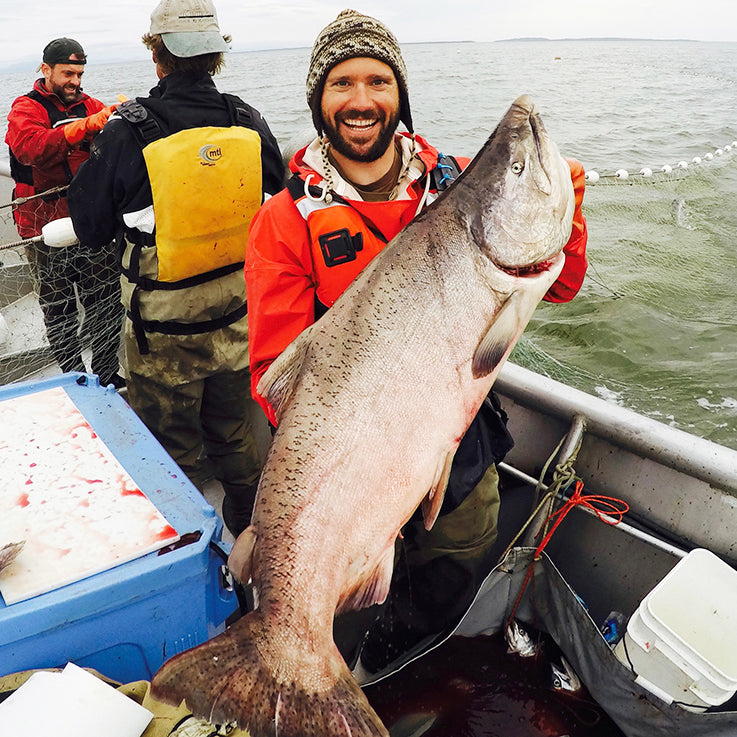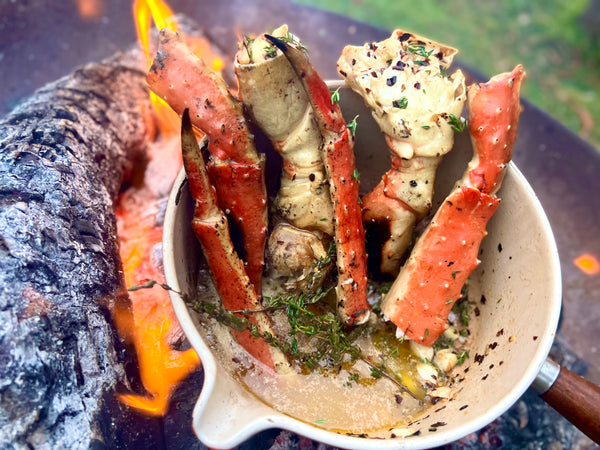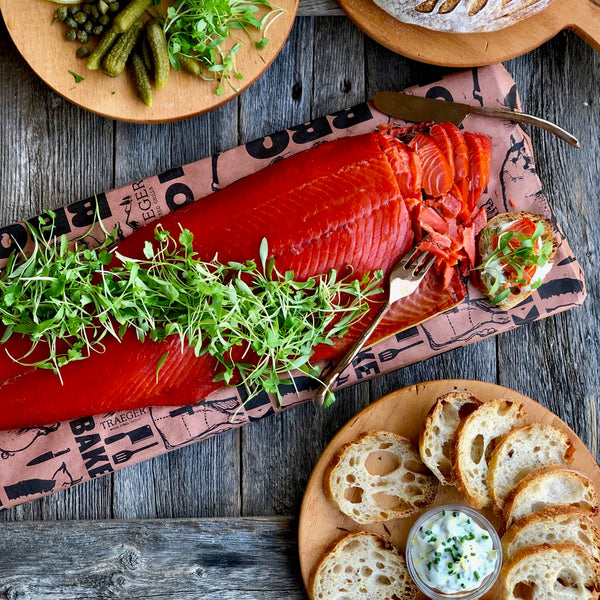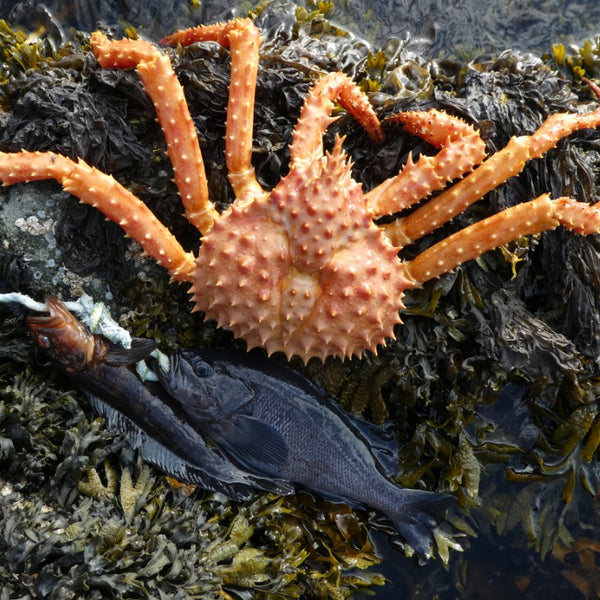Know your Seafood

These days it can be hard to understand exactly how our food is produced. Even the simplest of foods often have complicated production, elaborate processing and convoluted transportation. I think it's safe to say that most of us want our food produced honestly and processed minimally. In that spirit I thought I would expound on how the seafood you get from me is produced and Alaskan seafood in general.

Commercial Vs. Sport Fishing
First, it's worth noting that, in Alaska as in most places, only fish caught commercially can be sold. Sport caught fish cannot be sold. This means you should eliminate any image from your mind of a lone fisherman casting a rod into a deep river hole for your dinner. Paul (Brad Pitt) from A River Runs Through It cannot sell his catch, dreamy as he and his catch may be. When you enjoy wild Alaskan seafood, it was caught by a commercial fisherman with a commercial permit of some type. See my next post for more information on commercial fisheries and their management. It's fascinating!
King Salmon
Also called chinook, this species is prized by most above all other salmon. They are the largest of the five species of wild Alaskan salmon and have both a mild salmon flavor and rich taste. King salmon are caught in a variety of different ways, including seine, drift, setnet, and troll. King salmon have the distinction of being the only salmon species available to fishermen year round. While the other four species are caught at specific, and often brief, times of the summer, usually as they return to their natal river, king salmon are caught offshore (when Fish and Game allows) through the spring, summer, fall, and sometimes even mid-winter. While kings are caught by seine, setnet, and drift fishermen during the spring and early summer, troll fishermen are the ones catching "sea-run kings" year round in the open ocean. This fishery is primarily based out of Southeast Alaska (the Panhandle of the state) with small to medium sized boats, often with crews of just 1 or 2 and lines trailing from the stern with hooks and lures or bait. Trolling is the commercial fishery that most resembles sport fishing.
Kings return to their natal river to spawn in the spring, usually May and June. They have spots on their backs and on both lobes of their tails. The insides of their mouths are black. King salmon are very delicate and need to be handled extremely carefully by fishermen. When we catch these set netting, we cradle them as gently as a baby as they come over the side of the boat. King salmon eat mostly small high-oil fish––hence their rich taste. The color of their flesh is usually a typical "salmon" color. King salmon spend 3-7 years at sea before returning to their natal river to spawn. Some populations of king salmon travel incredible distances to reach their spawning grounds. Yukon River kings routinely travel 2,000 across Alaska, all the way to Canada. Female king salmon lay 3-14,000 eggs in a gravel nest, or redd, usually located in deep fast moving water. The male fertilizes the eggs with milt. Like all salmon, both adults die after spawning. The eggs hatch in late winter or early spring. The alevins remain in the gravel for several weeks while they absorb their yolk sack. Once their yolk sack is gone, the tiny fry make their way up through the gravel. While some fry immediately make their way to the sea, others remain in the river for one year before heading to the sea as smolt. King salmon sexually mature anywhere from two to seven years of age, meaning spawning salmon can vary greatly in size from just a few pounds (for a 3 year old fish) to 50 or more lbs. (for a six or seven year old fish). The world record king salmon was 58" and 126 lbs.

Coho Salmon - Coho Salmon, also called silver salmon, are large and delicious, considered by many to be second only to king salmon in richness. Coho are caught by seine, drift, setnet, and troll fishermen. Unlike king salmon, coho are typically caught by all fishing methods in the fall, when they return to the river to spawn. August and September are peak months for coho salmon fishing, but lots of coho can still be around as late as October and November. Female coho lay 2,400 to 4,500 eggs in a redd while a male fertilizes them. The eggs hatch in early spring and the alevins remain in the gravel until early summer, when they make their way up through the gravel as fry. The fry immediately seek out a lake or other calm water where they spend three to five years before heading to the sea as smolt. The young fish grow very quickly in the ocean and after about 18 months, they return to their natal river as adults weighing 8-12 pounds and measuring 24-30 inches long. Like kings, coho eat small fish. They are very brighter silver when in the ocean with black spots on their backs and on the top lobe of their tails (king salmon have black spots on both lobes of their tails). Coho also have some silver on their tails.
Sockeye Salmon - Also called red salmon, sockeye are probably the most ubiquitous wild salmon available to buy. Sockeye are known for their brilliant red/orange flesh that is truly stunning to behold. The reason for this stunning red flesh is what they eat. Unlike the other species, sockeye eat zoo plankton/krill––tiny crustaceans, not unlike shrimp, that float nearly invisible (to us) in the water column. This is what whales eat. The color in their pink/red shells is passed on to the salmon and tints their flesh. Sockeye are firm fleshed salmon, which means it's a firmer eating salmon, but also they are less susceptible to bruising and other damage when caught and processed. Sockeye have a distinct wild salmon flavor––one would never mistake a wild sockeye for any other species in appearance or taste. While most people love the color and taste, some find it too salmony. That's OK, there's a salmon species for everyone!
While all salmon undergo physical changes as they enter fresh water, male sockeye in particular undergo one of the most dramatic transformations. Their bodies change from bright silver to bright red, while their heads turn brilliant moss green. Their backs form a dramatic hump and their noses elongate and hook down while large teeth sprout from their gums. But don't worry, we harvest sockeye just as they enter the river from the ocean when they are chrome bright and gorgeous. While in the ocean, sockeye are bright silver with a lovely dark blue-green back and a while belly.
Sockeye return to their natal river to spawn mid-summer--June and July. Sockeye have very specific habitat requirements––most prefer a river, going to a lake, with small rivers or creeks flowing into that lake. Sockeye spawn in those uppermost creeks and sometimes in the lake itself. While other species only need a simple creek to complete their life cycle, sockeye need something very special. Bristol Bay, Alaska has this type of habitat in spades and that's why it's the largest salmon run on earth, with as many as 75 million sockeye returning to spawn each summer (and that number doesn't even include the other 4 species!).
Once the female finds a suitable location for her redd, she lays 2-5,000 eggs while a male fertilizes them. The eggs hatch over the winter and live in the gravel until the spring, when they emerge as fry. The fry spend 1-3 years in the lake before heading downriver to the ocean to mature. Sockeye travel thousands of miles while in the ocean, spending most of their time in the Gulf of Alaska. In 1-3 years, fat from the sea, the mature sockeye salmon return to their natal river to spawn. Sockeye can range from just a pound or two all the way up to 15 pounds. On the Ugashik River most of our fish are 4-6 pounds but we do catch 8-10 lbs fish sometimes. Sockeye salmon are caught commercially with seine, drift, and setnet gear. Since they eat krill, they will not bite lures at sea so troll fishermen don't catch them.

Other Salmon Species
The remaining two species are pink salmon (also called humpies) and chum salmon (also called keta or dog salmon). Although we do have these species on the Ugashik River, we catch very few and we do not sell them to customers. Although these species are lovely when first landed, for a variety of reasons they are not suitable for me to process and sell to customers.
Halibut
Although halibut is well known and very popular, there is still a lot to know about this prized flat fish, both from an ecological and culinary point of view. Halibut are the largest of the world's flatfish with a maximum size of over 8 ft. and more than 500 lbs. Halibut live their adult life on the sea floor in depth from just a few feet up to many thousands of feet deep. Halibut spawn in deeper water November through March, laying anywhere from a few thousand to many millions of eggs, depending on the size of the female. Young hatch in about two weeks and drift in deep open water as vertically oriented fish with one eye on each side of their heads. Over several months they move higher in the water column and nearer to shore. During this time one eye "migrates" to the other side of their head and the eyeless side starts to turn white. At about 6 months of age, they settle to the bottom as proper flat fish with the white side on the bottom and the mottled brown and black side facing up as camouflage. This incredible transformation is called "orbital migration." Female halibut grow much larger and much faster than males. Rarely is a male over 3 feet or 100 lbs. I sell only small halibut (less than 30 lbs.). These taste far better and are a much more sustainable size to catch and consume. Because halibut travel such great distances (a halibut tagged in Alaska's Bering Sea was caught off the coast of Oregon), commercial halibut fishing is regulated not by the states but by the International Pacific Halibut Commission (IPHC). Very large halibut are sometimes called "barn doors," while very small halibut are called "chickens." Halibut are commercially fished by long line. These ground lines are many thousands of feed long with anchors on either end and baited hooks every few fathoms in between.

Something called a "left-handed" or "left-eyed" halibut is a strange anomaly I have come across personally. If you are looking at virtually any halibut brown-side-up (eye-side-up) on a fillet table with its head to your right, the gills will be facing you. However, on a left-handed halibut, which are approximately 1 in 20,000, when the fish is in this same orientation, the gills will be facing away from you. On a particularly torturous commercial halibut fishing trip in the Gulf of Alaska years ago, I encountered this nearly mythical fish. It was extremely rough and we hadn't slept in 52 hours. Stumbling from one part of the deck to another, I would bump into things as the boat rocked and I'd fall asleep on my feet leaning there for a few seconds, until the boat pitched the other way and I'd go staggering off somewhere else. My job was gilling and gutting the halibut that were coming over the side on the long line. For hours on end I did the same thing––pick up a fish off the deck by my feet, lay it on the fillet table with its head to my right, and with a series of quick cuts and movements, remove the gills and guts before icing the fish in the hold. I did this over and over in the exact same way as the hours, then days bled to together. After gilling and gutting hundreds of halibut, I hoisted a fish to the table only to find that where I would normally cut, I couldn't. I had a left-handed halibut on my hands. In my overtired state, I couldn't understand what had happened so I stood there wide eyed and confused for at least a few minutes before someone stepped in to help me.

Sablefish
Also called black cod or sometimes butterfish, sablefish is the little-known star of Alaskan white fish. It's rich buttery taste is never fishy and it's clean white, flaky flesh is really something amazing to cook with. While most sablefish are in the 8 lb range, the largest fish can reach 55 lbs. and over four feet long. Sablefish spawn in deep water with females laying 110 eggs per gram of body weight. This means a typical female will lay more than 400,000 eggs each year. The young drift to coastal waters where they mature to about two years old. They then migrate back to the deep water (500-5,000 ft.) they will call home for the rest of their lives. While king and coho salmon are top predators of young sablefish, sperm whales are thought to be the most significant predator of adult sablefish. In parts of Alaska, fishermen can hardly get their fish aboard because sperm whales have learned to lay on the surface near the boat as they haul their fish in. The whales nibble each fish off the hook as they come up, infuriating fishermen in the process. Mother sperm whales have been seen teaching their young to do this. Many fishermen have switched to pot fishing sablefish for this reason.
King Crab
Red king crab are large and delicious crab fished commercially fished mainly in Bristol Bay and the Bearing Sea, but found around the state. The largest king crab can weigh 24 lbs. and have a leg span of 5 ft. Male king crab grow larger than females and can be distinguished by their long tail flap folded underneath their body. Females keep their eggs in their wide tail flap for a year while the eggs mature. When the eggs hatch, the larvae float on the currents undergoing several body changes while feeding on plankton. After a few months they are about dime-sized and settle to the sea floor looking for the first time like tiny king crab. King crab molt their shells often as young crab, then less often as they mature. Males often don't molt for a year or two. These are called "skip molts"––my customers sometimes receive these large crab full of character.
When I was young my parents and I lived in Unalaska/Dutch Harbor, the epicenter of the red king crab fishery. This was during the heyday of the king crab fishery and a bar called the Elbow Room, where mason jars of free cocaine lined the bar, police were too afraid to enter, and Jimmy Buffet once played on the barn door-sized stage. Between the Elbow Room (the bar is long closed) and the TV show, The Deadliest Catch, king crab fishing has always been a cowboy fishery. Because it's based out of the extremely remote town of Unalaska where gale winds and mountainous seas are the norm, it will probably always be a frontier fishery.
For more information on Russian vs. U.S. king crab fisheries, have a look at my other blog post here.


Cedar getting the Christmas king crab feast ready.
Leave a comment
Comments will be approved before showing up.



